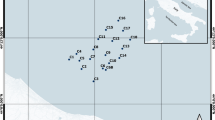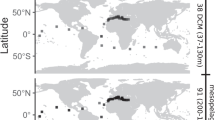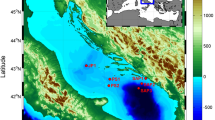Abstract
Interactions among microbes and stratification across depths are both believed to be important drivers of microbial communities, though little is known about how microbial associations differ between and across depths. We have monitored the free-living microbial community at the San Pedro Ocean Time-series station, monthly, for a decade, at five different depths: 5 m, the deep chlorophyll maximum layer, 150 m, 500 m and 890 m (just above the sea floor). Here, we introduce microbial association networks that combine data from multiple ocean depths to investigate both within- and between-depth relationships, sometimes time-lagged, among microbes and environmental parameters. The euphotic zone, deep chlorophyll maximum and 890 m depth each contain two negatively correlated ‘modules’ (groups of many inter-correlated bacteria and environmental conditions) suggesting regular transitions between two contrasting environmental states. Two-thirds of pairwise correlations of bacterial taxa between depths lagged such that changes in the abundance of deeper organisms followed changes in shallower organisms. Taken in conjunction with previous observations of seasonality at 890 m, these trends suggest that planktonic microbial communities throughout the water column are linked to environmental conditions and/or microbial communities in overlying waters. Poorly understood groups including Marine Group A, Nitrospina and AEGEAN-169 clades contained taxa that showed diverse association patterns, suggesting these groups contain multiple ecological species, each shaped by different factors, which we have started to delineate. These observations build upon previous work at this location, lending further credence to the hypothesis that sinking particles and vertically migrating animals transport materials that significantly shape the time-varying patterns of microbial community composition.
Similar content being viewed by others
Log in or create a free account to read this content
Gain free access to this article, as well as selected content from this journal and more on nature.com
or
References
Alarcón R, Waser NM, Ollerton J . (2008). Year-to-year variation in the topology of a plant–pollinator interaction network. Oikos 117: 1796–1807.
Albert R, Barabási A-L . (2002). Statistical mechanics of complex networks. Rev Mod Phys 74: 47–97.
Allers E, Wright JJ, Konwar KM, Howes CG, Beneze E, Hallam SJ et al. (2013). Diversity and population structure of Marine Group A bacteria in the Northeast subarctic Pacific Ocean. ISME J 7: 256–268.
Alonso-Sáez L, Balagué V, Sà EL, Sánchez O, González JM, Pinhassi J et al. (2007). Seasonality in bacterial diversity in north-west Mediterranean coastal waters: assessment through clone libraries, fingerprinting and FISH. FEMS Microbiol Ecol 60: 98–112.
Arumugam M, Raes J, Pelletier E, Le Paslier D, Yamada T, Mende DR et al. (2011). Enterotypes of the human gut microbiome. Nature 473: 174–180.
Barberán A, Bates ST, Casamayor EO, Fierer N . (2011). Using network analysis to explore co-occurrence patterns in soil microbial communities. ISME J 6: 343–351.
Beman JM, Popp BN, Francis CA . (2008). Molecular and biogeochemical evidence for ammonia oxidation by marine Crenarchaeota in the Gulf of California. ISME J 2: 429–441.
Beman JM, Steele JA, Fuhrman JA . (2011). Co-occurrence patterns for abundant marine archaeal and bacterial lineages in the deep chlorophyll maximum of coastal California. ISME J 5: 1077–1085.
Bonilla-Findji O, Herndl GJ, Gattuso J-P, Weinbauer MG . (2009). Viral and flagellate control of prokaryotic production and community structure in offshore Mediterranean waters. Appl Environ Microbiol 75: 4801–4812.
Bothe H, Tripp HJ, Zehr JP . (2010). Unicellular cyanobacteria with a new mode of life: the lack of photosynthetic oxygen evolution allows nitrogen fixation to proceed. Arch Microbiol 192: 783–790.
Brown MV, Lauro FM, DeMaere MZ, Muir L, Wilkins D, Thomas T et al. (2012). Global biogeography of SAR11 marine bacteria. Mol Syst Biol 8: 595.
Brown MV, Schwalbach MS, Hewson I, Fuhrman JA . (2005). Coupling 16 S-ITS rDNA clone libraries and automated ribosomal intergenic spacer analysis to show marine microbial diversity: development and application to a time series. Environ Microbiol 7: 1466–1479.
Carlson C, Morris R, Parsons R, Treusch A, Giovannoni S, Vergin K . (2009). Seasonal dynamics of SAR11 populations in the euphotic and mesopelagic zones of the northwestern Sargasso Sea. ISME J 3: 283–295.
Chaffron S, Rehrauer H, Pernthaler J, von Mering C . (2010). A global network of coexisting microbes from environmental and whole-genome sequence data. Genome Res 20: 947–959.
Chow C-ET, Kim DY, Sachdeva R, Caron DA, Fuhrman JA . (2014). Top-down controls on bacterial community structure: microbial network analysis of bacteria, T4-like viruses and protists. ISME J 8: 816–829.
Chow C-ET, Sachdeva R, Cram JA, Steele JA, Needham DM, Patel A et al. (2013). Temporal variability and coherence of euphotic zone bacterial communities over a decade in the Southern California Bight. ISME J 7: 2259–2273.
Coleman T, Moré J . (1983). Estimation of sparse Jacobian matrices and graph coloring blems. SIAM J Numer Anal 20: 187–209.
Collins LE, Berelson W, Hammond DE, Knapp A, Schwartz R, Capone D . (2011). Particle fluxes in San Pedro Basin, California: A four-year record of sedimentation and physical forcing. Deep Sea Res Part Oceanogr Res Pap 58: 898–914.
Cram JA, Chow C-ET, Sachdeva R, Needham DM, Parada AE, Steele JA et al. (2014a). Seasonal and interannual variability of the marine bacterioplankton community throughout the water column over ten years. ISME J 9: 563–580.
Cram JA, Sun F, Fuhrman JA . (2014b). Marine bacterial, archaeal and protistan association networks. In:Encyclopedia of Metagenomics, Springer Reference. New York: Springer, 1–10.
Dabney A, Storey JD . (2004). Q-value estimation for false discovery rate control. Medicine 344: 539–548.
Dunne JA, Williams RJ, Martinez ND . (2002). Food-web structure and network theory: The role of connectance and size. Proc Natl Acad Sci USA 99: 12917–12922.
Eiler A, Heinrich F, Bertilsson S . (2012). Coherent dynamics and association networks among lake bacterioplankton taxa. ISME J 6: 330–342.
Faust K, Raes J . (2012). Microbial interactions: from networks to models. Nat Rev Microbiol 10: 538–550.
Faust K, Sathirapongsasuti JF, Izard J, Segata N, Gevers D, Raes J et al. (2012). Microbial co-occurrence relationships in the human microbiome. PLoS Comput Biol 8: e1002606.
Freilich S, Kreimer A, Meilijson I, Gophna U, Sharan R, Ruppin E . (2010). The large-scale organization of the bacterial network of ecological co-occurrence interactions. Nucleic Acids Res 38: 3857–3868.
Fuhrman JA . (2009). Microbial community structure and its functional implications. Nature 459: 193–199.
Fuhrman JA, Cram JA, Needham DM . (2015). Marine microbial community dynamics and their ecological interpretation. Nat Rev Microbiol 13: 133–146.
Fuhrman J, Steele J . (2008). Community structure of marine bacterioplankton: patterns, networks, and relationships to function. Aquat Microb Ecol 53: 69–81.
Gilbert JA, Steele JA, Caporaso JG, Steinbrück L, Reeder J, Temperton B et al. (2012). Defining seasonal marine microbial community dynamics. ISME J 6: 298–308.
Giovannoni SJ, Vergin KL . (2012). Seasonality in ocean microbial communities. Science 335: 671–676.
Hatosy SM, Martiny JBH, Sachdeva R, Steele J, Fuhrman JA, Martiny AC . (2013). Beta diversity of marine bacteria depends on temporal scale. Ecology 94: 1898–1904.
Humphries MD, Gurney K . (2008). Network ‘small-world-ness’: a quantitative method for determining canonical network equivalence. PLoS ONE 3: e0002051.
Ings TC, Montoya JM, Bascompte J, Blüthgen N, Brown L, Dormann CF et al. (2009). Review: Ecological networks – beyond food webs. J Anim Ecol 78: 253–269.
Johnson ZI . (2006). Niche partitioning among Prochlorococcus ecotypes along ocean-scale environmental gradients. Science 311: 1737–1740.
Jürgens K, Matz C . (2002). Predation as a shaping force for the phenotypic and genotypic composition of planktonic bacteria. Antonie Van Leeuwenhoek 81: 413–434.
Jurgens K, Pernthaler J, Schalla S, Amann R . (1999). Morphological and compositional changes in a planktonic bacterial community in response to enhanced protozoan grazing. Appl Environ Microbiol 65: 1241–1250.
Kara EL, Hanson PC, Hu YH, Winslow L, McMahon KD . (2012). A decade of seasonal dynamics and co-occurrences within freshwater bacterioplankton communities from eutrophic Lake Mendota, WI, USA. ISME J 7: 680–684.
Kiørboe T . (2001). Formation and fate of marine snow: small-scale processes with large-scale implications. Sci Mar 65: 57–71.
Kiørboe T, Hansen JLS . (1993). Phytoplankton aggregate formation: observations of patterns and mechanisms of cell sticking and the significance of exopolymeric material. J Plankton Res 15: 993–1018.
Lücker S, Nowka B, Rattei T, Spieck E, Daims H . (2013). The Genome of Nitrospina gracilis Illuminates the Metabolism and Evolution of the Major Marine Nitrite Oxidizer. Front Microbiol 4: 27.
Malfatti F, Azam F . (2009). Atomic force microscopy reveals microscale networks and possible symbioses among pelagic marine bacteria. Aquat Microb Ecol 58: 1–14.
Malfatti F, Samo TJ, Azam F . (2009). High-resolution imaging of pelagic bacteria by Atomic Force Microscopy and implications for carbon cycling. ISME J 4: 427–439.
Miller MB, Bassler BL . (2001). Quorum sensing in bacteria. Annu Rev Microbiol 55: 165–199.
Montoya JM, Pimm SL, Solé RV . (2006). Ecological networks and their fragility. Nature 442: 259–264.
Needham DM, Chow C-ET, Cram JA, Sachdeva R, Parada A, Fuhrman JA . (2013). Short-term observations of marine bacterial and viral communities: patterns, connections and resilience. ISME J 7: 1274–1285.
Newman MEJ . (2006). Modularity and community structure in networks. Proc Natl Acad Sci USA 103: 8577–8582.
Olesen JM, Bascompte J, Dupont YL, Jordano P . (2007). The modularity of pollination networks. Proc Natl Acad Sci USA 104: 19891–19896.
Ruan Q, Dutta D, Schwalbach MS, Steele JA, Fuhrman JA, Sun F . (2006). Local similarity analysis reveals unique associations among marine bacterioplankton species and environmental factors. Bioinformatics 22: 2532–2538.
Schnetzer A, Moorthi SD, Countway PD, Gast RJ, Gilg IC, Caron DA . (2011). Depth matters: Microbial eukaryote diversity and community structure in the eastern North Pacific revealed through environmental gene libraries. Deep Sea Res Part Oceanogr Res Pap 58: 16–26.
Smoot ME, Ono K, Ruscheinski J, Wang PL, Ideker T . (2011). Cytoscape 2.8: new features for data integration and network visualization. Bioinformatics 27: 431–432.
Steele JA, Countway PD, Xia L, Vigil PD, Beman JM, Kim DY et al. (2011). Marine bacterial, archaeal and protistan association networks reveal ecological linkages. ISME J 5: 1414–1425.
Steinberg DK, Carlson CA, Bates NR, Goldthwait SA, Madin LP, Michaels AF . (2000). Zooplankton vertical migration and the active transport of dissolved organic and inorganic carbon in the Sargasso Sea. Deep Sea Res Part Oceanogr Res Pap 47: 137–158.
Steinberg DK, Goldthwait SA, Hansell DA . (2002). Zooplankton vertical migration and the active transport of dissolved organic and inorganic nitrogen in the Sargasso Sea. Deep Sea Res Part Oceanogr Res Pap 49: 1445–1461.
Strom SL . (2008). Microbial ecology of ocean biogeochemistry: a community perspective. Science 320: 1043–1045.
Suweis S, D’Odorico P . (2014). Early warning signs in social-ecological networks. PLoS ONE 9: e101851.
Swan BK, Martinez-Garcia M, Preston CM, Sczyrba A, Woyke T, Lamy D et al. (2011). Potential for chemolithoautotrophy among ubiquitous bacteria lineages in the dark ocean. Science 333: 1296–1300.
Team RDC. (2011) R: A Language and Environment for Statistical Computing. Vienna: : Austria, http://www.R-project.org/.
Thornton DCO . (2014). Dissolved organic matter (DOM) release by phytoplankton in the contemporary and future ocean. Eur J Phycol 49: 20–46.
Watts DJ, Strogatz SH . (1998). Collective dynamics of ‘small-world’ networks. Nature 393: 440–442.
Wilson SE, Steinberg DK . (2010). Autotrophic picoplankton in mesozooplankton guts: evidence of aggregate feeding in the mesopelagic zone and export of small phytoplankton. Mar Ecol Prog Ser 412: 11–27.
Wright JJ, Mewis K, Hanson NW, Konwar KM, Maas KR, Hallam SJ . (2013). Genomic properties of Marine Group A bacteria indicate a role in the marine sulfur cycle. ISME J 8: 455–468.
Xia LC, Ai D, Cram J, Fuhrman JA, Sun F . (2013). Efficient statistical significance approximation for local similarity analysis of high-throughput time series data. Bioinformatics 29: 230–237.
Zhou J, Deng Y, Luo F, He Z, Tu Q, Zhi X . (2010). Functional molecular ecological networks. mBio 1: e00169–10.
Acknowledgements
This study would not have been possible without the support of numerous present and past members of the SPOT team. We especially thank C Chow, J Steele, A Parada, C Roney, D Kim, D Capone and D Caron, and three anonymous reviewers for help and advice. This work was supported by NSF grant numbers 0703159, 1136818 and grant GBMF3779 from the Gordon and Betty Moore Foundation Marine Microbiology Initiative, and the Wrigley Institute for Environmental Studies.
Author information
Authors and Affiliations
Corresponding author
Ethics declarations
Competing interests
The authors declare no conflict of interest.
Additional information
Supplementary Information accompanies this paper on The ISME Journal website
Supplementary information
Rights and permissions
About this article
Cite this article
Cram, J., Xia, L., Needham, D. et al. Cross-depth analysis of marine bacterial networks suggests downward propagation of temporal changes. ISME J 9, 2573–2586 (2015). https://doi.org/10.1038/ismej.2015.76
Received:
Revised:
Accepted:
Published:
Issue date:
DOI: https://doi.org/10.1038/ismej.2015.76
This article is cited by
-
Symbiotic UCYN-A strains co-occurred with El Niño, relaxed upwelling, and varied eukaryotes over 10 years off Southern California
ISME Communications (2023)
-
Rapid shifts in pond sediment microbiota in response to high ambient temperature in a water–sediment microcosm
Environmental Science and Pollution Research (2023)
-
Combined organic-inorganic fertilization builds higher stability of soil and root microbial networks than exclusive mineral or organic fertilization
Soil Ecology Letters (2023)
-
Earth microbial co-occurrence network reveals interconnection pattern across microbiomes
Microbiome (2020)
-
Statistical significance approximation for local similarity analysis of dependent time series data
BMC Bioinformatics (2019)



